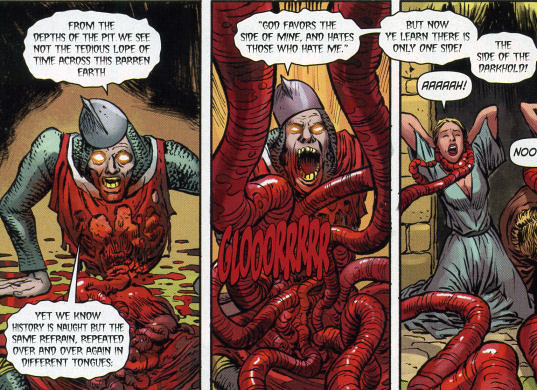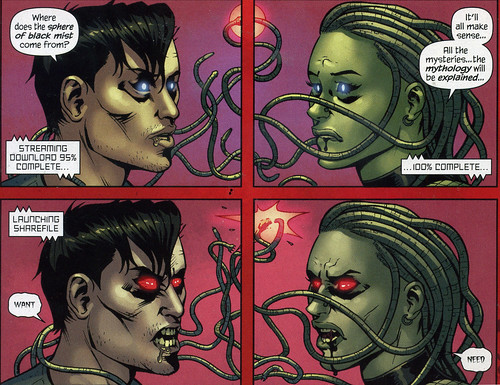Review of Marvel Zombies 5 #3-4
We’re catching up on our backlog of review materials here at the ZRC, so pardon a few combination reviews to catch up, if you please, Z-Rights fans.
Marvel Zombies is well known around here for its far-less-than-friendly depictions of the Differently Animated, and that’s not likely to change any time soon as Marvel’s overall editorial policy toward Zombies is anything but enlightened. MZ5′s premise of exploring the various media concepts of Zombie in a wide variety of alternate-dimensional takes on Marvel history or even regular human history has allowed it to stretch the anti-Zombie bias toward previously excluded forms of Zombiism, however, which extends the reach of the stereotyping unfortunately employed by ZRC Outreach participant and writer Fred Van Lente in this work.
MZ3 concerns the ‘Raimi’ subtype of Zombie, which posed an interesting question for the ZRC: are the Deadites, popularized in Sam Raimi’s Evil Dead movies, actually Zombies, and as such, clients for the Zombie Rights Campaign?
We here at the ZRC try to be as expansive in our definition of ‘Zombie’ as possible, so as to serve as many clients as we are able. We gladly work on behalf of a wide variety of beings typically classed as Undead, from biologically active but ‘infected’, to Undead and animated by empirically derived causes (whether chemical, viral or extraterrestrial), to the classic Voodoo Zombie, animated by rituals and magic, or perhaps merely chemicals and suggestion.
Raimi’s creations, however, seem to be of another class. Deadites aren’t so much individual beings as they are a collective force, a force Raimi, at least, unambiguously describes as evil. Yes, the movies are called Evil Dead, but Deadites aren’t, in fact, all dead. In many cases, the force behind the Deadites possesses a living person, and what’s more, that possession is sometimes partial, and even reversible. If the person whose body is inhabited by a Deadite is still around, do they not have some claim to it? Likewise, are you really dealing with a group of individuals who are in need of civil rights advocacy, or a single, larger creature that is invading our dimension and quite frankly seems beyond human law?
These questions abound during the reading of MZ5 Number 3, which concerns an Army of Darkness style invasion of Marvel’s version of Camelot by Deadite-like creatures animated by the Marvel Universe’s own book of ultimate evil, the Darkhold. These creatures promptly put the Arthurian civilization under siege, spreading outward and converting the recently felled into more Deadites. All we’re missing is Bruce Campbell in a cape!
Into this mixture the three MZ protagonists wade, seeking a sample of this strain of Zombiism to continue concoting a ‘cure’ for the ailment. Along the way, the not-quite-Deadites get pretty philosophical, not that our dimension-hopping trio take much time to discuss existential matters before unloading copious amounts of lead into skulls.

Seen here: Demon, Zombie, or Philosophy Student with Intesti-tentacles? You decide.
So, are Deadites demons, or Zombies? Well… we’re going to err on the side of caution. Raimi-type semi-Zombie creatures may not quite fit in our usual mandate, and their mass antisocial outbursts can be disturbing, but let’s try to have some empathy here. How would YOU like being awakened from thousands of years of sleep in an ancient tome of lore by a gaggle of college students on break? Or how about being stuck in the pages of a manuscript in some dusty medieval tower, eh? Maybe the Darkhold is just trying to get out and see the world in the only way it knows how. Maybe instead of fearing these ‘evil’ books, we should try to engage them in productive dialogue instead.
I mean, let’s face it. If violence and gunpowder were going to resolve this conflict, they’d have done so already.
Next up, the trio travel to a Cyberpunk dystopia that is about to meet its own version of Zombies.
Yes, you read that correctly. Issue 4 concerns a concept rarely explored in Zombie-bashing literature, and the cyberpunk stylings and in particular the apt translation of Marvel icons into the rebellious, technical jargon laden language stereotypical of the form, made for a refreshing reading.
Well, until the Zombies showed up and of course it all became about violence and mayhem instead of discussion and empowerment.
This universe takes place in the near future, where your standard All Powerful Tech Company runs the world. Hackers, including a sad, cyborg version of Amadeus Cho, are looking to steal the latest and greatest season opener of an X-Files style show put out by said company, but unfortunately it’s a trap designed to spread, well, an entirely different kind of Zombie Virus.

Warning kids! Filesharing may lead to Zombiism, and that’s apparently A Bad Thing ™
There’s some significant character development that I won’t go into here (mostly because it doesn’t concern our Undead clients), and these Cyber-Zombies don’t come off as villains so much as junkies; their condition is even, in some cases, reversible, and the entire outbreak is a nefarious plot whose details I won’t divulge here. Still, even as Zombies travel boldly into the techno-future, they are burdened with the unfair expectations of society that they devour and maim and run amok. Why must it always be so? Why can’t we get along with our Cybernetic Undead Citizens?
On that note, despite two thought-provoking takes on the concept of the Zombie archetype, the ZRC has to soundly and thoroughly condemn these violence laden, gore-splattered comics creations. Unlike the example that Marvel has set with Deadpool and his Zombie Head counterpart, there is no redeeming or uplifting message here for Zombies. For robots, sure. Redemption, development, even romance. But Zombies?
They’re still waiting for their time in the sun.


Positive aspects of an On-line Company Administration Diploma On the web
It is a form of on the internet advertising and marketing by writing small posts related to your enterprise theme or industry. Right after you have composed your personal content articles, you will be able to make them freely available for distribution and publication in the marketplace. Each post includes a “useful resource box” or “bio box” and “by-line” such as the authors references and make contact with info. If you can publish effectively-created posts, then you will have the potential of obtaining credibility in your business, as well as your audience.